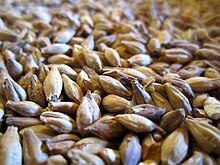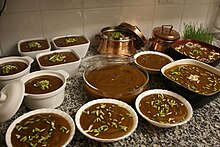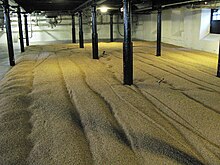Malt


Maltis anycerealgrainthat has been made to germinate by soaking in water and then stopped from germinating further by drying with hot air, a process known as "malting".[1][2][3][4] Malted grain is used to makebeer,whisky,malted milk,malt vinegar,confections such asMaltesersandWhoppers,flavored drinks such asHorlicks,Ovaltine,andMilo,and some baked goods, such asmalt loaf,bagels,andRich Teabiscuits. Malted grain that has been ground into a coarse meal is known as "sweet meal".[5][6]
Malting grain develops theenzymes(α-amylase, β-amylase) required for modifying the grains'starchesinto various types of sugar, includingmonosaccharideglucose,disaccharidemaltose,trisaccharidemaltotriose,and higher sugars calledmaltodextrines.It also develops other enzymes, such asproteases,that break down theproteinsin the grain into forms that can be used byyeast.The point at which the malting process is stopped affects thestarch-to-enzyme ratio, and partly converted starch becomes fermentable sugars.
Malt also contains small amounts of other sugars, such assucroseandfructose,which are not products of starch modification, but which are already in the grain. Further conversion to fermentable sugars is achieved during themashingprocess.

Various cereals are malted, thoughbarleyis the most common. A high-protein form of malted barley is often a label-listed ingredient in blended flours typically used in the manufacture of yeast bread and other baked goods.[7] The term"malt"refers to several products of the process: the grains to which this process has been applied, for example, malted barley; the sugar, heavy in maltose, derived from such grains, such as the baker's malt used in various breakfast cereals;single malt whisky,often called simply "single malt"; or a product based on malted milk, similar to a malted milkshake (i.e. "malts" ).
History and traditional usage
[edit]
Malted grains have probably been used as an ingredient of beer since ancient times, for example in Egypt (Ancient Egyptian cuisine),Sumer,and China.
InPersiancountries, a sweet paste made entirely from germinated wheat is calledsamanū(Persian:سمنو) inIran,samanak(Persian:سمنک) inAfghanistan,(Tajik:суманак); (Uzbek Latin:sumalak) orsümölök(Kyrgyz:сүмөлөк), which is prepared forNowruz(Persian new year celebration) in a large pot (like akazan). A plate or bowl ofsamanuis a traditional component of theHaft sin tablesymbolising affluence. Traditionally, women have a special party to prepare it during the night, and cook it from late in the evening until the daylight, singing related songs. InTajikistanandAfghanistan,they sing:Samanak dar Jūsh u mā Kafcha zanēm – Dīgarān dar Khwāb u mā Dafcha zanēm[8][9](meaning:"Samanak is boiling and we are stirring it, others are asleep and we are playingdaf"). In modern times, makingsamanucan be a family gathering. It originally comes from the GreatPersian Empire.[citation needed]
Mämmi,or Easter Porridge, is a traditionalFinnishLentenfood. Cooked from rye malt and flour,mämmihas a great resemblance (in the recipe, color, and taste) tosamanū.Today, this product is available in shops from February until Easter. A (nonrepresentative) survey in 2013 showed that almost no one cooksmämmiat home in modern-dayFinland.[10]
Malting
[edit]
Malting is the process of converting barley or other cereal grains into malt for use in brewing,distilling,or foods, and takes place in amaltings,sometimes called a malthouse, or a malting floor. The cereal is spread out on the malting floor in a layer of8 to 12 centimetres (3 to4+1⁄2inches) depth.[11]
- Drying
- The malting process starts with drying the grains to a moisture content below 14% and then storing for around six weeks to overcomeseed dormancy.
- Steeping
- When ready, the grain is immersed orsteepedin water two or three times for two or three days to allow the grain to absorb moisture and to start tosprout.
- Germination
- When the grain has a moisture content of around 46%, it is transferred to the malting or germination floor, where it is constantly turned over for about four to six days while it is air-dried.[12]
- Pre-toasting
- The grain at this point, called "green malt", is then dried and toasted in an oven (orkiln) to the desired color and specification.[13]Malts range in color from very pale through crystal and amber to chocolate or black malts.[14]
- Smoking
- The sprouted grain is then further dried and smoked by spreading it on a perforated wooden floor. Smoke coming from anoastingfireplace(via smoke channels) is then used to heat the wooden floor and the sprouted grains. The temperature is usually around 55 °C (131 °F).
A "maltings" is typically a long, single-storey building with a floor that slopes slightly from one end of the building to the other. Floor maltings began to be phased out in the 1940s in favor of "pneumatic plants", where large industrial fans are used to blow air through the germinating grain beds and to pass hot air through the malt being kilned. Like floor maltings, these pneumatic plants use batch processes, but of considerably greater size, typically 100-ton batches compared with 20-ton batches floor maltings.
As of 2014[update],the largest malting operation in the world was Malteurop, which operates in 14 countries.[15]
Production
[edit]Barley is the most commonly malted grain, in part because of itshigh contentofenzymes,though wheat,rye,oats,rice, andcornare also used.[16]Also very important is the retention of the grain'shusk,even afterthreshing,unlike the bare seeds of threshed wheat or rye. This protects the growingacrospire(developing plantembryo) from damage during malting, which can easily lead tomoldgrowth; it also allows themashof converted grain to create a filter bed duringlautering.
Malts
[edit]Diastatic and nondiastatic
[edit]As all grains sprout, natural enzymes within the grain break down thestarchof which the grain is composed into simpler sugars, which taste sweet and are easier for yeast to use as food. Malt with active enzymes is called "diastatic malt". Malt with inactive enzymes is called "nondiastatic malt". The enzymes are deactivated by heating the malt.
Base and specialty
[edit]Malt is often divided into two categories by brewers: base malts and specialty malts.
Base maltshave enough diastatic power to convert their own starch and usually, that of some amount of starch from unmalted grain, calledadjuncts.
Specialty maltshave little diastatic power, but provide flavor, color, or "body" (viscosity) to the finished beer. Specialtycaramelor crystal malts have been subjected to heat treatment to convert their starches to sugars nonenzymatically.[citation needed]Within these categories is a variety of types distinguished largely by the kilning temperature.
Two-row and six-row
[edit]In addition, barley malts are distinguished by the two major cultivar types of barley used for malting, two-row, and six-row.[17][18]
Malt extract
[edit]

Malt extract, also known as extract of malt, is a sweet,treacle-like substance used as adietary supplement.[19]It was popular in the first half of the 20th century as a nutritional enhancer for the children of theBritishurban working class, whose diet was often deficient invitaminsand minerals. Children were givencod liver oilfor the same reason, but it proved so unpalatable that it was combined with extract of malt to produce "Malt and Cod-Liver Oil."
The 1907British Pharmaceutical Codex's instructions for making a nutritional extract of malt do not include amashoutat the end of extraction and include the use of lower mash temperatures than is typical with modern beer-brewing practices. TheCodexindicates that diastatic activity is to be preserved by the use of temperatures not exceeding 55 °C (131 °F).
Malt extract production
[edit]Malt extract is frequently used in the brewing of beer. Its production begins by germinating barley grain in a process known as malting, immersing barley in water to encourage the grain to sprout, then drying it to halt the progress when the sprouting begins. The drying step stops the sprouting, but the enzymes remain active due to the low temperatures used in base malt production.[20]In one before-and-after comparison, malting decreased barley's extractable starch content by about 7% on a dry matter basis and turned that portion into various other carbohydrates.[21]

In the next step, brewers use a process called mashing to extract the sugars. Brewers warm cracked malt in temperature-modulated water, activating the enzymes,[22]which cleave more of the malt's remaining starch into various sugars, the largest percentage of which ismaltose.[21]Modern beer-mashing practices typically include high enough temperatures at mash-out to deactivate remaining enzymes, thus it is no longerdiastatic.The liquid produced from this,wort,is then concentrated by using heat or a vacuum procedure to evaporate water[19]from the mixture. The concentrated wort is called malt extract.
Malt extract types
[edit]Two forms of malt extract are used by brewers: liquid malt extract (LME), containing about 20% water, and dry malt extract (DME), dehydrated to 2% water. LME is a thick syrup that typically gives off more pleasant flavors than its counterpart, while DME provides better consistency in color. When using large amounts of extract, LME is typically used because its ability to dissolve in boiling temperatures, whereas DME can clump up and become difficult to liquefy. However, those in favor of DME, enjoy its longer shelf life.[23]LME is also sold in jars as a consumer product.
A new encapsulating technology permits the production ofmalt granules.This process dries and coats layers of wort such that flavoring substances within the original wort are not volatilized during storage or transport, further extending shelf life, and reducing dust during handling. This new process may allow for more centralized and standardized production of the extract than what would have been traditionally prepared at individual breweries.[24]
Research
[edit]Scientists aim to discover what happens inside barley grains as they become malted to help plant breeders produce better malting barley for food and beverage products. The United StatesAgricultural Research Servicescientists are interested in specialized enzymes called serine-classproteases[25]that digest beta-amylases, which convert carbohydrates into "simple sugars" during the sprouting process.[26]The enzyme also breaks down stored proteins into their amino-acid derivatives. The balance of proteins and carbohydrates broken down by the enzyme affects the malt's flavor.
Enzyme-rich malt extract
[edit]Enzyme-rich malt extract (ERME) is a specialised form of barley malt extract (marketed by Ateria Health[27]), that has undergone preparation to activate the naturalamylaseandglucanaseenzymes in the grain. Initially researched as anequinefood supplement,[28][29]pilot studies using ERME as a humanfood supplementhave suggested that it could potentially improve the symptoms ofIrritable Bowel Syndrome (IBS)and chronicconstipation,[30]due to the way it can break down carbohydrates in the small intestine that IBS has been found to hinder.[31]However further research is ongoing to fully prove this link.[32][33]
See also
[edit]References
[edit]- ^"How to brew manuallyby John Palmer ".Retrieved6 October2014.
- ^"Quality Factors for Malting, Brewing and other End-uses".Oregon State University. Archived fromthe originalon 4 October 2017.Retrieved13 April2007.
- ^"What is malting?".Retrieved6 October2014.
- ^Kirk-Othmer Food and Feed Technology.New York: Wiley-Interscience. 2007. pp. 116–120.ISBN978-0-470-17448-7.Retrieved7 July2010.
- ^Horace Kephart (1922).Our southern highlanders(eBook ed.). New York: The Macmillan Company. p.134.Retrieved10 April2011.
The sprouted corn is then dried and ground into meal. This sweet meal is then made into a mush with boiling water, and is let stand two or three days.
- ^Mills, Margaret H.; Claus, Peter J.; Diamond, Sarah (2003).South Asian folklore: an encyclopedia: Afghanistan, Bangladesh, India, Nepal, Pakistan, Sri Lanka.New York: Routledge. p. 5.ISBN0-415-93919-4.Retrieved10 April2011.
The grain's own conversion of stored starch to sugar while sprouting ('malting') results in a sweet meal, which is then cooked for hours with water, oil, and additional wheat flour.
- ^Evers, A. D.; Kent, N. (1994).Technology of cereals: an introduction for students of food science and agriculture.New York: Pergamon Press. p. 181.ISBN0-08-040834-6.Retrieved7 July2010.
- ^"Nowruz in Afghanistan,BBC Persian "(in Persian).Retrieved6 October2014.
- ^"24 ساعت – نو روز باستانی در کشور عزیز ما افغانستان".24sahat.com.Archived fromthe originalon 7 March 2016.Retrieved27 March2013.
- ^"How to tame your mämmi?Porridge and Potatoes
- ^"Malting – Whisky.com".www.whisky.com.
- ^"UK Malt, the Maltsters' Association of Great Britain | How malt is made".www.ukmalt.com.Retrieved24 February2019.
- ^"How Malt is Made".www.ukmalt.com. Archived fromthe originalon 17 July 2011.Retrieved26 March2011.
- ^Michael Lewis; Tom W. Young (31 October 2002).Brewing.Springer, 2002. p. 204.ISBN9780306472749.Retrieved26 March2011.
- ^"Bad barley crop probably won't affect beer prices".Frederick News-Post.Associated Press.4 January 2015.
- ^"Wheat and Rye Malt Use in Brewing Beer".www.beer-brewing.com. Archived fromthe originalon 24 May 2013.Retrieved26 March2011.
- ^Goldhammer, Ted (2008),The Brewer's Handbook,2nd ed., Apex,ISBN0-9675212-3-8,p. 31 ff.
- ^"Two-Row vs Six-Row Barley".Zymurgy,1 May 2013, American Homebrewers Association. Retrieved 7 October 2020
- ^abBritish pharmaceutical codex.Pharmaceutical Society of Great Britain. 1907. pp.401–404.Retrieved28 March2011.
The extract is given to children and adults for its nutritive properties.... Extract of malt is used as a vehicle for the administration of cod-liver oil (see Extractum Malti cum Oleo Morrhuae),...
- ^Joseph La Villa (2010).The Wine, Beer, and Spirits Handbook: A Guide to Styles and Service.John Wiley & Sons, Inc. p. 347.ISBN978-0-470-53757-2.Retrieved30 March2011.
The base malt in any brewing process is called pale malt. It is dried at around 122 °F (50 °C). Specialty malts are made either by heating the barley before it is dry or by roasting the dried malt.
- ^abStevens, Roger; Dennis E. Briggs; Chris Boulton; Brookes, Peter (2004).Brewing: science and practice.Cambridge: Woodhead. p. 123.ISBN0-8493-2547-1.Retrieved29 March2011.See tables 4.15 & 4.16
- ^"How to Brew – By John Palmer – Mashing Defined".Retrieved28 March2011.
- ^"DME vs LME".www.urbanbrewers.com.Retrieved18 August2022.
- ^"Patent EP1385931 Malt Granules".www.freepatentsonline.com. Archived fromthe originalon 2 October 2012.Retrieved25 May2009.
- ^"Like Malt? You'll Love This Malting Barley Research!".USDA Agricultural Research Service. 2 February 2010.
- ^"Secrets to Superb Malting Barleys Explored by ARS Researchers".USDA Agricultural Research Service. 3 February 2010.Retrieved7 March2011.
- ^"Our Ingredient – Ateria Health Ltd".ateriahealth.com.Retrieved11 October2023.
- ^Hunter, JO (2009)."Do horses suffer from irritable bowel syndrome?".Equine Veterinary Journal.41(9): 836–40.doi:10.2746/042516409X474284.PMID20383978.
- ^Proudman, C. J.; Hunter, J. O.; Darby, A. C.; Escalona, E. E.; Batty, C.; Turner, C. (June 2014) [2014]."Characterisation of the faecal metabolome and microbiome of Thoroughbred racehorses".Equine Veterinary Journal.47(5): 580–586.doi:10.1111/evj.12324.ISSN0425-1644.PMID25041526.S2CID1473275.
- ^Haworth, Jordan; Bloor, Sarah; Hobson, Anthony (June 2022) [June 2022]."P230 Open label pilot study: an enzyme-rich malt extract (ERME™) for the treatment of chronic constipation".BMJ.71(Suppl 1). BMJ Publishing Group Ltd and British Society of Gastroenterology: A153.1–A153.doi:10.1136/gutjnl-2022-BSG.284.S2CID249904295.
- ^King, TS; Elia, M; Hunter, JO (1998) [October 10, 1998]."Abnormal colonic fermentation in irritable bowel syndrome".The Lancet.352(9135): 1187–1189.doi:10.1016/s0140-6736(98)02146-1.ISSN0140-6736.PMID9777836.S2CID1750363.
- ^Cunningham, Andrew.Can an enzyme-rich malt extract improve the symptoms of irritable bowel syndrome?(Report). ISRCTN.doi:10.1186/isrctn14173715.
- ^Edith Cowan University, Perth (6 April 2021)."Does Enzyme Rich Malt Extract improve symptoms and quality of life for those with Irritable Bowel Syndrome?".ECU.Retrieved3 October2023.
Further reading
[edit]- D. E. Briggs,Malts and Malting,Kluwer Academic / Plenum Publishers (30 September 1998),ISBN0-412-29800-7
- Clark, Christine,The British Malting Industry Since 1830,Hambledon Continuum (1 July 1998),ISBN1-85285-170-8
